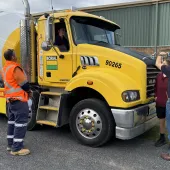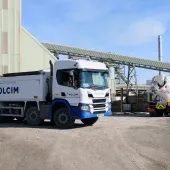A new approach to driving safety standards

Aggregate Industries adopt new policy as dangerous lorry driving continues to hit the headlines
WITH dangerous lorry driving continuing to hit the headlines, Aggregate Industries have asserted that businesses must be extra diligent in ensuring the safety credentials of their haulage providers.
Throughout 2017 there was an influx of headlines about examples of poor lorry driving that had led to structural damage of property and infrastructure, accidents and, most tragically of all, fatalities.
As part of an ongoing crackdown on bad driving etiquette by Highways England, November 2017 saw one UK county conduct secret filming which captured a number of HGV drivers using their mobile phones, watching YouTube videos and even reading books behind the wheel.
Moreover, new research by Network Rail has revealed that five oversized lorries crash into a low bridge in Britain each day; a figure which rises to 10 a day in October and November, due to the clocks changing and a spike in Christmas deliveries. This comes as two fifths (43%) of lorry drivers admit to not knowing the correct size of their vehicle.
Ben Young, head of road logistics at Aggregate Industries, commented: ‘The increase in reported dangerous lorry driving in the news last year was shocking and it’s something that all businesses, whether operating their own fleet or using a transport provider, have a duty to address.
‘At Aggregate Industries, for example, we operate a robust theory and practical testing process when recruiting a new haulier, which includes requiring them to achieve a minimum of FORS Bronze accreditation – which is followed up with regular monitoring and maintenance as part of our safety programme.
‘Also, in a progressive move forward for our industry, we recently launched ‘Fair & Just’ – a new transparent points-based policy designed to improve standards further. Although most drivers deliver high standards on a consistent basis, we wanted a fair and transparent approach to dealing with the few occasions where standards drop, which might include driving dangerously.’
This latest news comes at a time when the demand on UK roads has never been greater. According to the latest statistics by the Department for Transport, HGV vehicles moved a record 170 billion tonnes of goods in 2016, a year-on-year increase of 15% and a trend that shows no sign of abating anytime soon.
Mr Young continued: ‘Whilst the vast majority of drivers are sensible behind the wheel, there are still some who have fallen into bad habits, putting themselves and others in danger.
‘With the demand on commercial vehicles and, in turn, traffic increasing, it’s vital that we take action now to raise safety standards for all. One of the things we have done to combat this is introduce a system to monitor driving style within each vehicle, so we can educate and further improve the behaviours of drivers working on our business.
‘By adopting a rigorous approach to their in-house fleet or outsourced transport providers, which includes ongoing testing, monitoring, and a ‘firm-but-fair’ approach to dangerous driving, businesses can help to negate some of the risk on the roads.’









